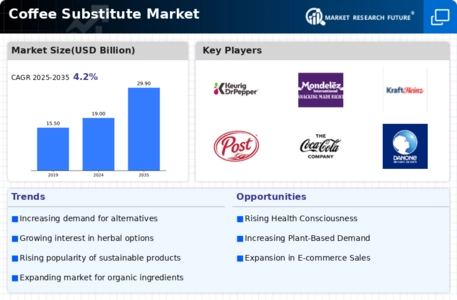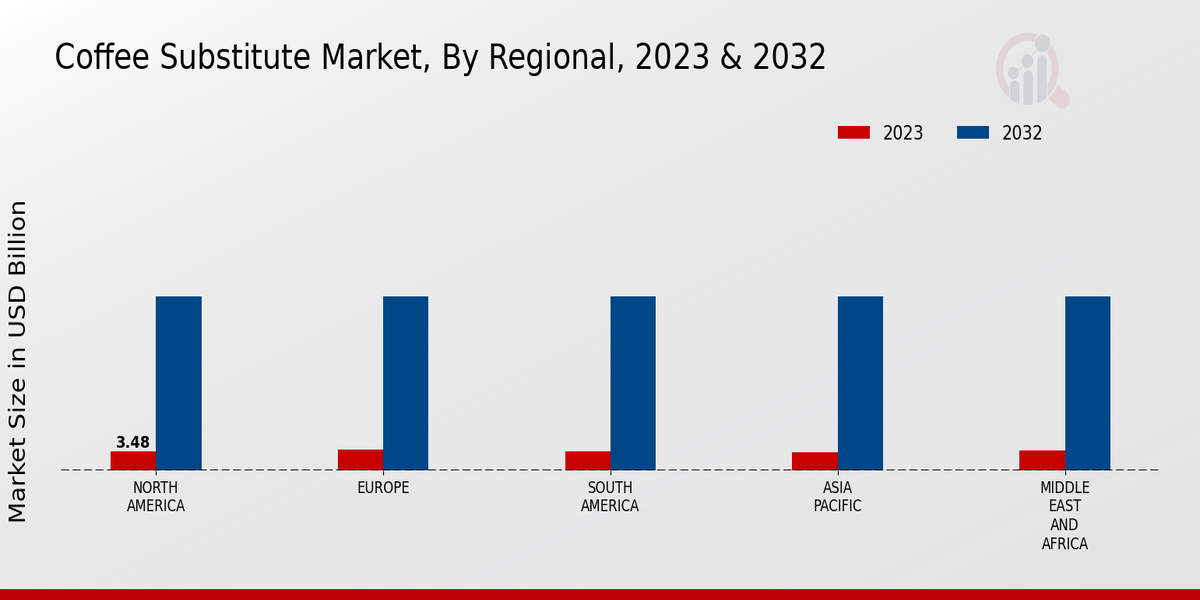Diverse Flavor Profiles
The Global Coffee Substitute Market Industry benefits from the introduction of diverse flavor profiles that cater to varying consumer preferences. Manufacturers are innovating by creating blends that combine different ingredients, such as roasted grains and herbs, to produce unique taste experiences. This diversification not only attracts traditional coffee drinkers but also appeals to those seeking novel beverages. As the market continues to evolve, the availability of flavored coffee substitutes is expected to enhance consumer interest and engagement. This trend could contribute to the projected growth of the market, which is anticipated to reach 29.9 USD Billion by 2035.
Market Growth Projections
The Global Coffee Substitute Market Industry is poised for substantial growth, with projections indicating a market size of 19.0 USD Billion in 2024 and an anticipated increase to 29.9 USD Billion by 2035. This growth trajectory suggests a compound annual growth rate of 4.21% from 2025 to 2035, reflecting a robust demand for coffee alternatives. The increasing awareness of health benefits, coupled with the rise of sustainable and ethical consumption, is likely to drive this expansion. As consumer preferences continue to evolve, the market is expected to adapt, offering a variety of innovative products that cater to diverse tastes and dietary needs.
Rising Health Consciousness
The Global Coffee Substitute Market Industry experiences a notable surge in demand driven by increasing health consciousness among consumers. Many individuals are shifting away from traditional coffee due to concerns over caffeine consumption and its associated health risks. This trend is particularly evident in regions where consumers are actively seeking alternatives that offer health benefits, such as herbal and grain-based substitutes. The market is projected to reach 19.0 USD Billion in 2024, reflecting a growing preference for products perceived as healthier. As awareness of the adverse effects of excessive caffeine intake continues to rise, the Global Coffee Substitute Market Industry is likely to expand further.
Innovative Marketing Strategies
Innovative marketing strategies are crucial in driving the Global Coffee Substitute Market Industry forward. Brands are increasingly leveraging social media and influencer partnerships to reach a wider audience and promote their products. Engaging storytelling and educational content about the benefits of coffee substitutes are becoming common tactics to attract consumers. This approach not only raises awareness but also fosters brand loyalty among consumers who are curious about alternatives to traditional coffee. As marketing efforts become more sophisticated, the Global Coffee Substitute Market Industry is likely to witness enhanced visibility and growth.
Sustainability and Ethical Sourcing
Sustainability plays a pivotal role in shaping the Global Coffee Substitute Market Industry. Consumers are increasingly inclined towards products that are ethically sourced and environmentally friendly. Coffee substitutes made from ingredients like chicory, barley, and dandelion are often marketed as sustainable options, appealing to eco-conscious consumers. This trend aligns with the broader movement towards sustainable consumption, where individuals prioritize products that contribute positively to the environment. As the market evolves, brands that emphasize sustainable practices are likely to gain a competitive edge, further propelling the Global Coffee Substitute Market Industry towards growth.
Growing Vegan and Plant-Based Trends
The rise of veganism and plant-based diets significantly influences the Global Coffee Substitute Market Industry. As more consumers adopt these lifestyles, there is a corresponding increase in demand for plant-based alternatives to traditional coffee. Coffee substitutes made from grains, nuts, and seeds align well with the preferences of this demographic. The market is likely to see sustained growth as plant-based diets become more mainstream, with projections indicating a compound annual growth rate of 4.21% from 2025 to 2035. This trend underscores the importance of aligning product offerings with evolving dietary preferences to capture a broader consumer base.























